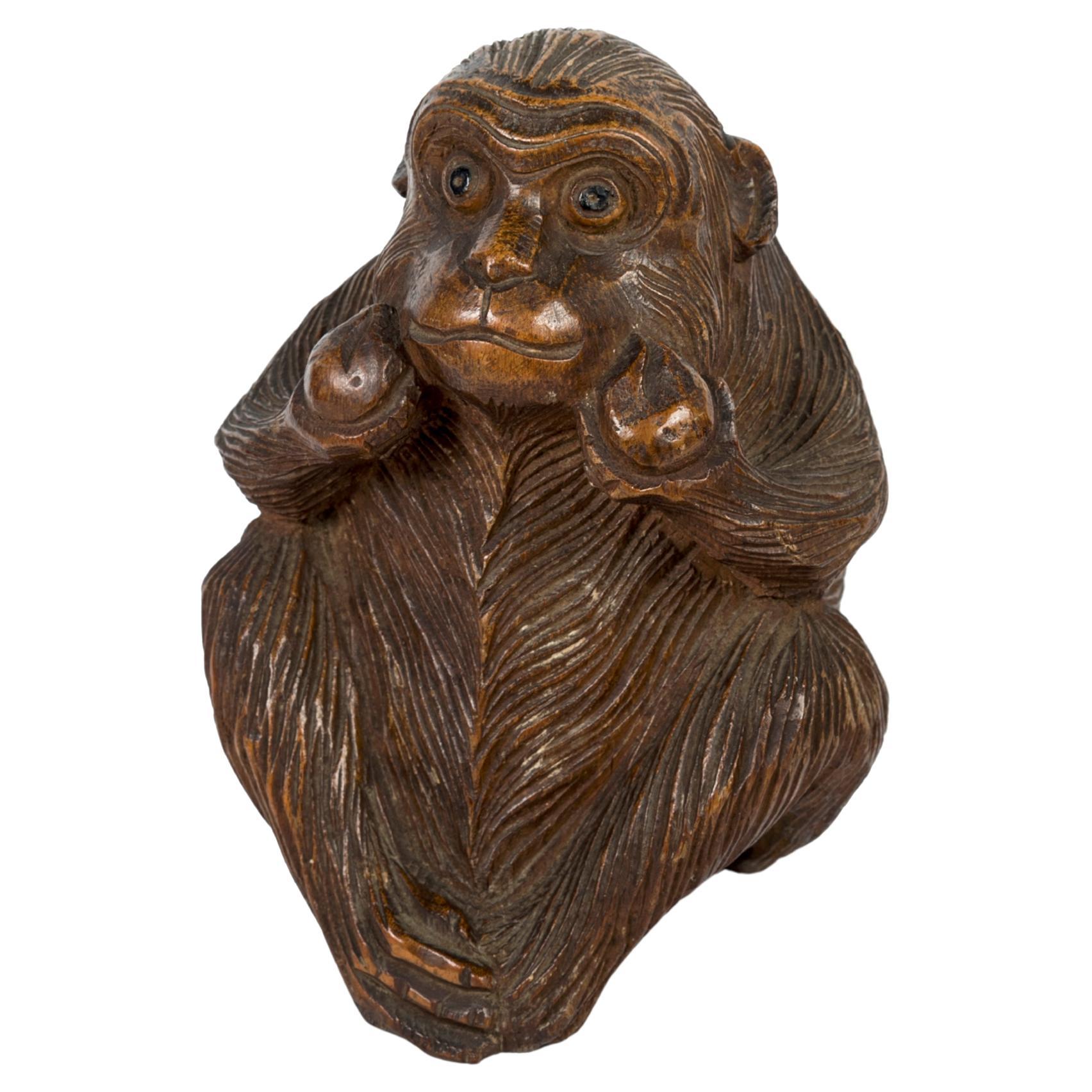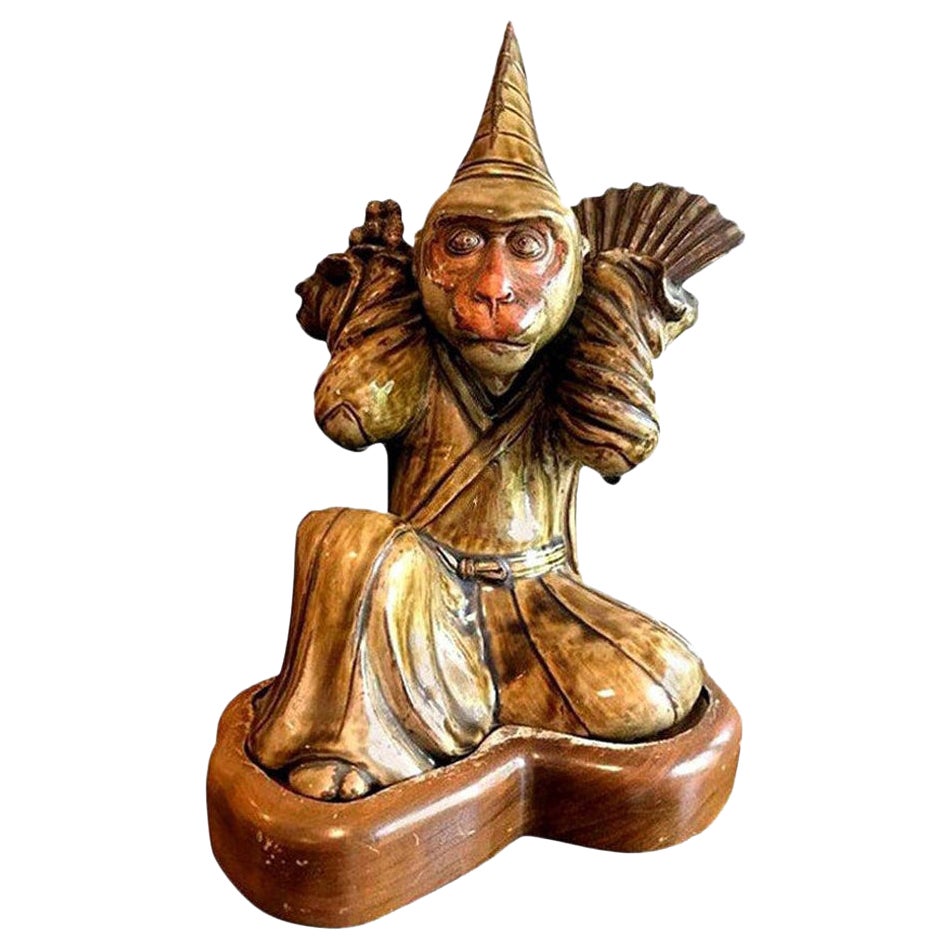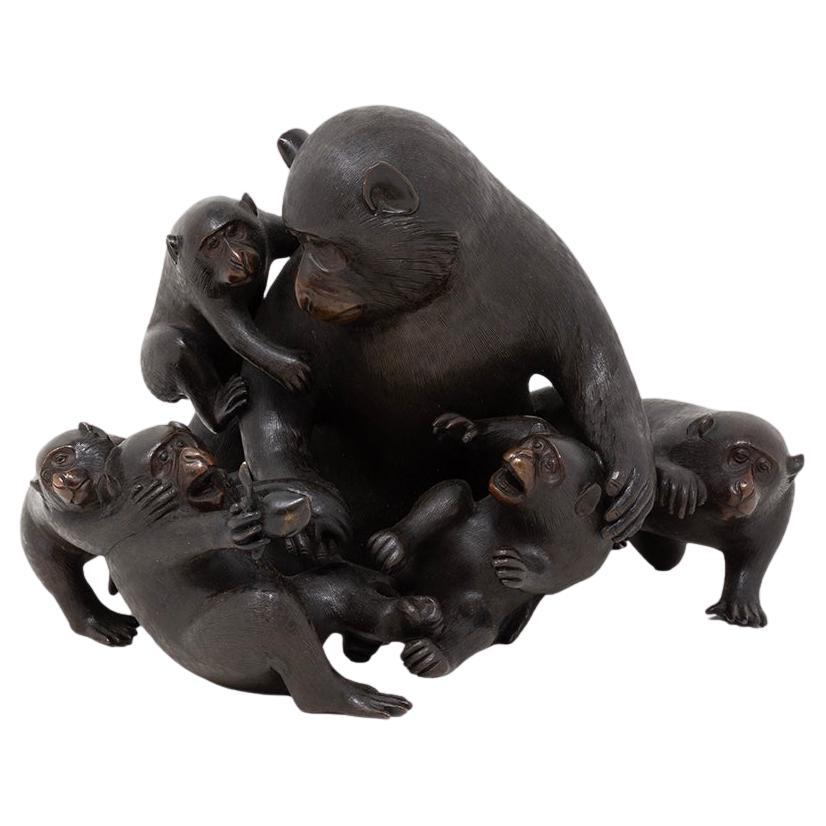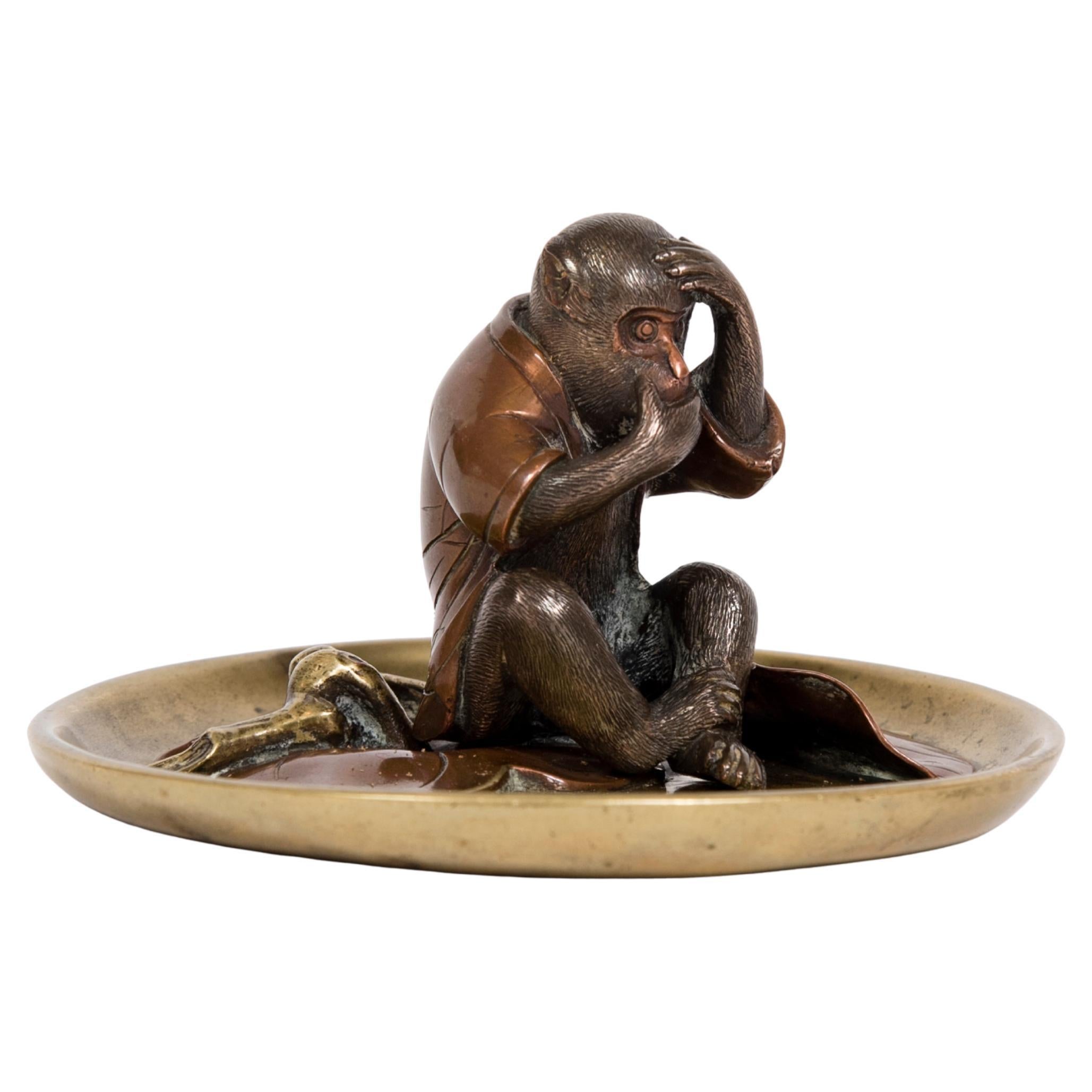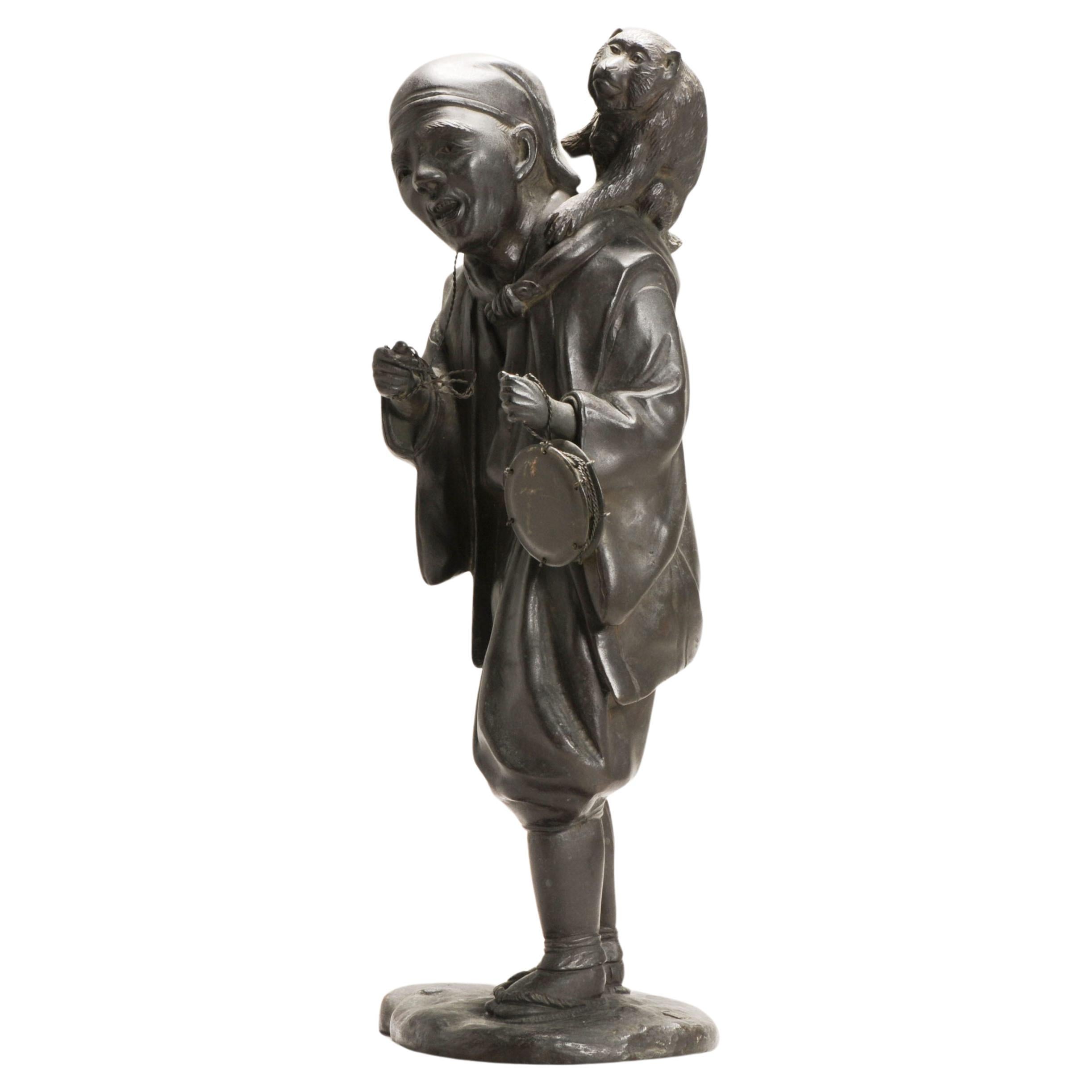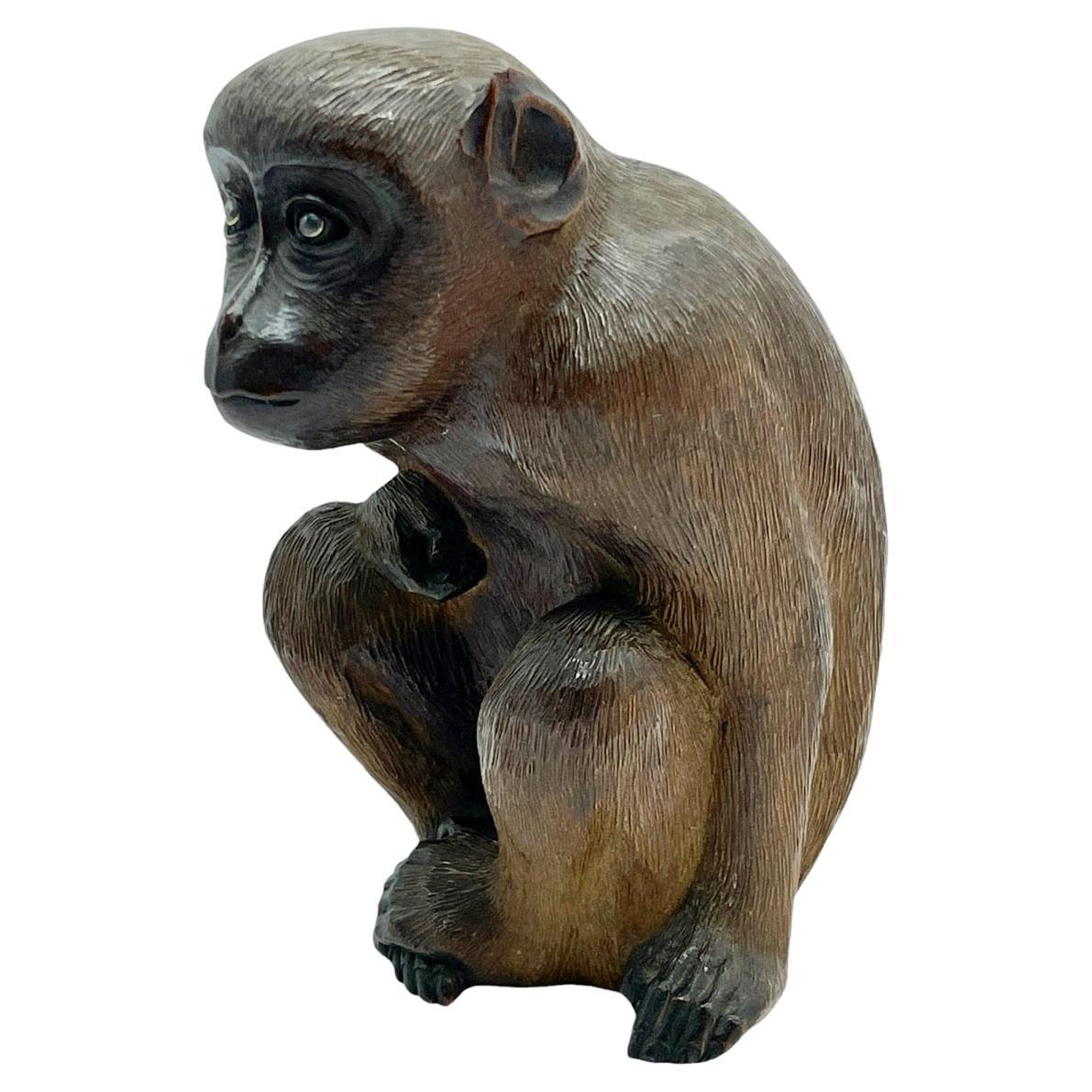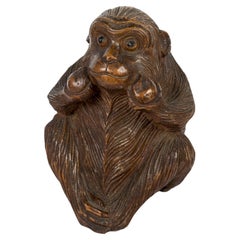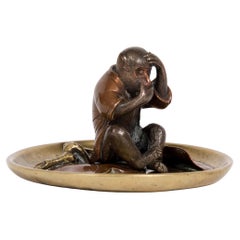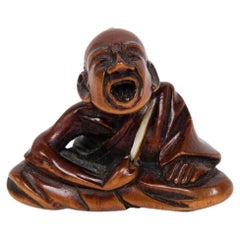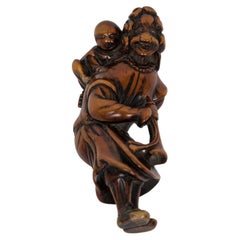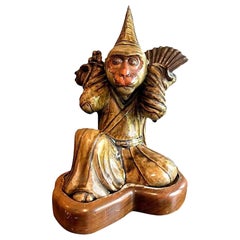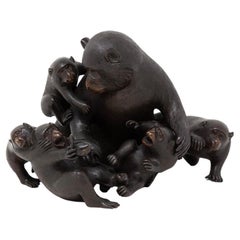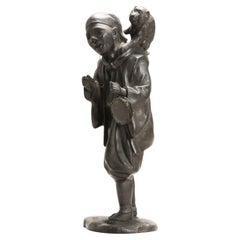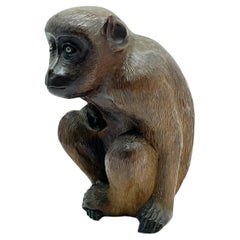Items Similar to Japanese Sumida-Gawa sculpture of a man distributing peaches to its monkeys
Want more images or videos?
Request additional images or videos from the seller
1 of 7
Japanese Sumida-Gawa sculpture of a man distributing peaches to its monkeys
$1,436.61
£1,059.72
€1,200
CA$1,990.49
A$2,159.99
CHF 1,144.60
MX$26,491.22
NOK 14,164.40
SEK 13,384.60
DKK 9,137.77
About the Item
Polychrome sculpture in Sumida-gawa stoneware, also called Sumida-yaki, representing an old man surrounded by five monkeys in front of a basket containing two nuts. Glazed clothes and basket. The figure of the monkey with longevity peaches is a popular image in China, however this subject was also widely used by the Japanese.
According to the legend the monkey Sun, king of monkeys, upset that he was not invited to the banquet of the Queen Mother, entered the garden of the goddess Xiwangmu in the mountains of Kun Lun and ate all the heavenly peaches she grew there. He became immortal.
Seal underneath of Kinoshita (木下).
Sumida-yaki ceramics takes its name from the Sumida River (Sumida gawa), near which it was created by Inoue Ryosai I (1828-1899) in 1875. He and the wealthy merchant Shimada Sobei built a kiln in the Hashiba district of Asakusa, in present-day Tokyo. The production of the Inoue family spans three generations: Inoue Ryosai I (1828-?), Inoue Ryosai II (around 1860-?) and Inoue Ryosai III (1880-1971). Alongside them, two other ceramists are also famous: Ishiguro Koko and Hara Yashiyama.
The ceramics are characterized by stoneware of rather heavy aspect, a very shiny glaze and most of the time, applied decorations in relief. It is decorated using the taka-uki-bori ("high relief carving") technique which consists of gluing shapes onto the porcelain. The glaze is then poured over the top, which gives the ceramics great vitality and freedom.
It was mainly exported to the West from the end of the 19th century to the 1920s from the port of Yokohama; and was mainly distributed in the United States through the A. A. Vantine's & Co. store, located on 5th Avenue in New-York and specialized in oriental and Far Eastern objects.
Made by Kitanoshita
Japan – Meiji era (1868-1912) or Taisho era (1912-1926), early 20th
Height: 3.74 in. (9.5 cm) – width: 4.45 in. (11.3 cm) – depth: 4.13 in. (10.5 cm)
- Dimensions:Height: 3.75 in (9.5 cm)Width: 4.45 in (11.3 cm)Depth: 4.14 in (10.5 cm)
- Style:Meiji (Of the Period)
- Materials and Techniques:
- Place of Origin:
- Period:
- Date of Manufacture:1868-1912
- Condition:Wear consistent with age and use.
- Seller Location:PARIS, FR
- Reference Number:Seller: 2022-10851stDibs: LU8311242789732
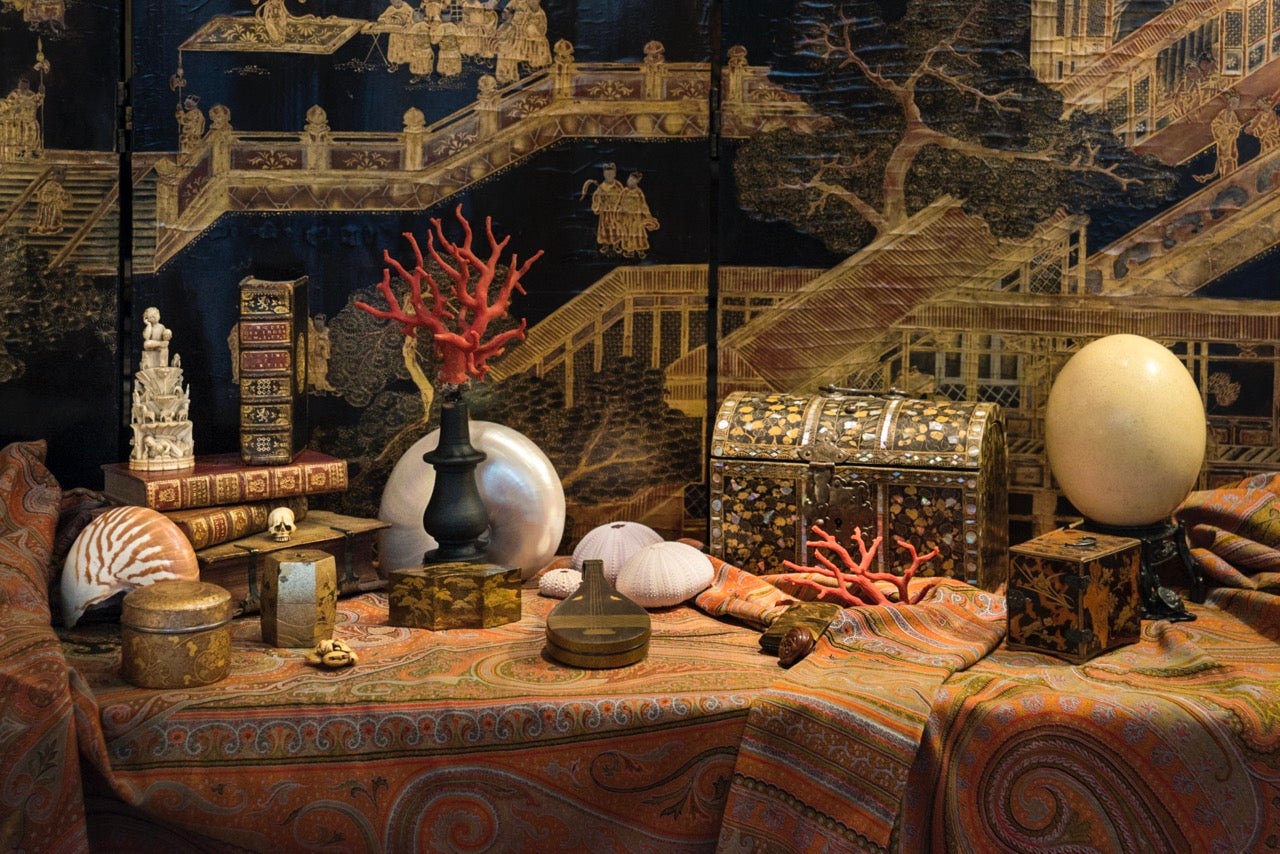
About the Seller
No Reviews Yet
Vetted Professional Seller
Every seller passes strict standards for authenticity and reliability
Established in 2013
1stDibs seller since 2023
Typical response time: <1 hour
- ShippingRetrieving quote...Shipping from: PARIS, France
- Return Policy
Authenticity Guarantee
In the unlikely event there’s an issue with an item’s authenticity, contact us within 1 year for a full refund. DetailsMoney-Back Guarantee
If your item is not as described, is damaged in transit, or does not arrive, contact us within 7 days for a full refund. Details24-Hour Cancellation
You have a 24-hour grace period in which to reconsider your purchase, with no questions asked.Vetted Professional Sellers
Our world-class sellers must adhere to strict standards for service and quality, maintaining the integrity of our listings.Price-Match Guarantee
If you find that a seller listed the same item for a lower price elsewhere, we’ll match it.Trusted Global Delivery
Our best-in-class carrier network provides specialized shipping options worldwide, including custom delivery.More From This Seller
View AllJapanese bamboo sculpture of a Monkey holding Longevity Peaches in its two hands
Located in PARIS, FR
Chiseled wood sculpture representing a seated monkey holding peaches of longevity in his hands. The impression of the fur is quite realistic, and its e...
Category
Antique Late 19th Century Japanese Meiji Sculptures and Carvings
Materials
Bamboo
Japanese Monkey Suaka
Located in PARIS, FR
Bronze sculpture of a monkey laying on a golden brass tray adorned with copper
leaves. This sculpture is made of sentoku and shibuchi bronze with a very interesting
suaka patina.
...
Category
Antique Late 19th Century Japanese Sculptures and Carvings
Materials
Bronze
$2,154
Japanese Professional sneezer Boxwood Netsuke
Located in PARIS, FR
Boxwood netsuke of a seated professional sneezer depicted as an old man with his right hand raised, holding an stick to tickle himself. His head is slightly raised, his eyes practica...
Category
Antique Late 18th Century Japanese Edo Sculptures and Carvings
Materials
Boxwood
Boxwood netsuke representing a ducthman with child and a trumpet
Located in PARIS, FR
Wooden netsuke of a standing Dutchman figure with his mouth open, leaning forward. He is wearing a long curly wig, a ruff and a long coat tied at the waist. In his right hand, the ma...
Category
Antique Late 18th Century Japanese Japonisme Sculptures and Carvings
Materials
Boxwood
Netsuke in the form of a No mask representing the character of Obeshimi
Located in PARIS, FR
Wooden netsuke depicting the Obeshimi mask in Noh theater.
Obeshimi is a demon characterized by thick eyebrows, eyes that seem to protrude from the face and a closed mouth.
Signed ...
Category
Antique Late 19th Century Japanese Meiji Sculptures and Carvings
Materials
Boxwood
Japanese Puppy Nestuke in boxwood
Located in PARIS, FR
Netsuke in boxwood representing a puppy with incrusted eyes made of buffalo horns. Its mouth is open, as if it was barking, it also wears a knotted collar and holds a ball between it...
Category
Antique Mid-19th Century Japanese Edo Sculptures and Carvings
Materials
Boxwood
You May Also Like
Japanese Signed Glazed Edo/Meiji Ceramic Pottery Monkey with Custom Wood Stand
Located in Studio City, CA
A truly fantastic and rather unique piece. The collectors we have shown have gone gaga over this piece.
Beautifully crafted and glazed with amazing detail to facial features.
...
Category
Antique 19th Century Japanese Meiji Ceramics
Materials
Ceramic
Japanese Meiji Period Bronze Monkey Group Sculpture Okimono Shosai
Located in Newark, England
Featuring Seven Japanese Macaques
Form our Japanese collection, we are delighted to offer this Japanese Bronze Monkey Group by Shosai. The Japanese Bronze Group displaying a male father monkey and his infants playing around and being mischievous with Persimmon fruit. The monkeys modelled as Japanese macaque monkeys (snow monkey). The bronze okimono is beautifully patinated with a highly lifelike and naturalistic casting signed to the underside Shosai 正齊鋳. The Bronze group dates to the Meiji Period (1868-1912) circa 1885.
Japanese macaque (snow monkey) is a terrestrial Old World monkey species that is native to Japan. They are known as snow monkeys because some live in areas where snow covers the ground for long periods each year hence their nickname. No other non-human primate lives further north or in a colder climate than the snow monkey. Individuals have brownish grey fur, pinkish-red faces, and short tails. Two subspecies are known and their conservation Status is of least concern. In Japan, the species is known as Nihonzaru ニホンザル, 日本 (Japan/Nihon) and saru 猿 (monkey) to distinguish it from other primates, but the Japanese macaque is the only species of monkey in Japan.
The Japanese macaque features heavily in the religion, folklore, and art of Japan, as well as in proverbs and idiomatic expressions in the Japanese language. They are often seen in paintings, block prints and represented in all manner of carvings from Okimono to netsuke. Many of these art forms reside in the world’s most famous museums and collections, some of the most prominent pieces by artists such as Mori Sosen and Kawanabe Kyosai. In Shinto belief (Japan’s indigenous religion/nature religion) legendary mythical beasts known as raiju sometimes appeared as monkeys and kept Raijin (the god of lightning/storms) company. In another well known tale the three wise monkeys who warn people to “see no evil, hear no evil and speak no evil” can be seen depicted in relief over the door of the famous Tosho-gu shrine in Nikko.
Meiji Period was an era of Japanese history that spanned from 1868 to 1912. It was the first half of the Empire of Japan, when the Japanese people began to build a paradigm of a modern, industrialised nation state and emergent great power, influenced by Western countries and aesthetics. As a result of radically different ideas, the changes to Japan were profound and it affected the social structure, politics, economy, military, and foreign relations across the board. The period corresponded to the reign of Emperor Meiji and was preceded by the Keio era and was succeeded by the Taisho era.
Cultural Art during the Meiji Period was of particular interest to the government and they overhauled the art export market which in turn promoted Japanese arts via various world’s fairs, beginning in Vienna at the world fair in 1873. The government heavily funded the fairs and took an active role organising how Japan’s culture was presented to the world including creating a semi-public company named Kiritsu Kosho Kaisha (First Industrial Manufacturing Company). The Kiritsu Kosho Kaisha was used to promote and commercialise exports of Japanese art and established the Hakurankai Jimukyoku (Exhibition Bureau) to maintain quality standards. For the 1876 Centennial International Exhibition in Philadelphia, the Japanese government created a Centennial Office and sent a special envoy to secure space for the 30,000 items that would be displayed. The Imperial Household also took an active interest in arts and crafts, commissioning works by select artists to be given as gifts for foreign dignitaries further emphasising the high quality and importance of Japanese art. Just before the end of the 19th century in 1890, the Teishitsu Gigeiin (Artist to the Imperial Household) system was created to recognise distinguished artists. These artists were selected for their exceptionally high quality wares and talent in their own industry. Over a period of 54 years Seventy artists were appointed, amongst these were ceramicist Makuzu Kozan and cloisonné enamel artist...
Category
Antique Late 19th Century Japanese Meiji Sculptures and Carvings
Materials
Bronze
Antique Seiya-sei for Genryusai Seiya Bronze Man and Monkey Statue Japan Meij
Located in Amsterdam, Noord Holland
BRONZE Seiya-sei for Genryusai Seiya Man and Monkey figure. Marked on base
Meiji era (1868-1912), 19th century
Condition
Condition is Perfect: Size 33.5 cm high
Period
19th century ...
Category
Antique 19th Century Japanese Meiji Ceramics
Materials
Metal, Bronze
$5,064 Sale Price
20% Off
19th Century 'Meiji Period' Japanese Carved Wood Seated Monkey Sculpture
Located in North Miami, FL
19th Century (Meiji Period) Japanese hand-carved wood seated monkey. The eyes are inlaid and made of glass. The fur and details are very realistic. The piece is signed on the bottom ...
Category
Antique 19th Century Japanese Meiji Animal Sculptures
Materials
Glass, Wood
Antique Okimono Bronze Japanese Statue Man Carrying Something Japan
Located in Amsterdam, Noord Holland
Description
Nicely made artifact of high quality. Basket is missing and we replaced it with a porcelain cup.
Condition
Overall Condition No real damages, just some ware. Size ...
Category
Antique 19th Century Japanese Meiji Ceramics
Materials
Bronze
$1,530 Sale Price
20% Off
Antique Chinese Export Porcelain Monkey, Likely Qing Dynasty w/ Paperwork
Located in Atlanta, GA
Please note the paperwork in photographs. Previously sold by Morland House who claimed Chien Lung Period Circa 1780. We belive this is later.
Chinese Export Porcelain Figural Monke...
Category
Antique 19th Century Chinese Chinese Export Ceramics
Materials
Porcelain
More Ways To Browse
Japanese Stoneware
Great Seal Of The United States
Garden China Made In Japan
Carved Monkey
Ceramic Monkey
Monkey Figure
Monkey Japan
Japanese Monkey
Peach Sculpture
Antique Hara
Sumida Gawa
Carved Asian Man Sculpture
Ryosai Inoue
Monkey Ceramic Japanese
Buddhist Lions
Cargo Porcelain
Qing Teapot
Antique Hand Painted Japanese Bowl
